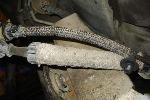AKForce
New Member
- Joined
- February 18, 2019
- Messages
- 9
- Reaction score
- 1
- Year, Model & Trim Level
- 09 Explorer 4.0
Hello all, long time reader, new poster.
09 Explorer 4.0 SOHC
Our explorer has a coolant leak that we cannot source. There is coolant pooled in several locations directly behind the thermostat housing essentially in a straight line. It does not seem to be coming from the head although we have not ruled it out. The car is not overheating at all, although we have had to add about a gallon of coolant over the last two weeks.
We had two hypotheses and are looking for validation on either or an entirely new concept.
The first is the intake manifold bypass cap. I cannot find for sure if that is a component in the 09, but seems to fit most of the symptoms.
The second relates to the previous owner. The thermostat housing cracked during his tenure and he JB Welded it together. Obviously it cracked later, and we replaced the housing. We later had to replace the radiator and water pump, although we are not sure they are related to the poorly repaired housing, but if they are could there be other stresses in the coolant system that could cause leaks?
Relevant repairs we have done are new thermostat and housing, radiator, water pump, tensioner pulley, top radiator hose.
We thoroughly checked the housing and it is not leaking. We don't think the head is leaking because there appears to be no internal signs of a blown gasket and the coolant is pooled in higher areas than the head. We do not think it is the intake manifold itself because we are not experiencing any other symptoms.
Any help would be thoroughly appreciated. Thanks!
09 Explorer 4.0 SOHC
Our explorer has a coolant leak that we cannot source. There is coolant pooled in several locations directly behind the thermostat housing essentially in a straight line. It does not seem to be coming from the head although we have not ruled it out. The car is not overheating at all, although we have had to add about a gallon of coolant over the last two weeks.
We had two hypotheses and are looking for validation on either or an entirely new concept.
The first is the intake manifold bypass cap. I cannot find for sure if that is a component in the 09, but seems to fit most of the symptoms.
The second relates to the previous owner. The thermostat housing cracked during his tenure and he JB Welded it together. Obviously it cracked later, and we replaced the housing. We later had to replace the radiator and water pump, although we are not sure they are related to the poorly repaired housing, but if they are could there be other stresses in the coolant system that could cause leaks?
Relevant repairs we have done are new thermostat and housing, radiator, water pump, tensioner pulley, top radiator hose.
We thoroughly checked the housing and it is not leaking. We don't think the head is leaking because there appears to be no internal signs of a blown gasket and the coolant is pooled in higher areas than the head. We do not think it is the intake manifold itself because we are not experiencing any other symptoms.
Any help would be thoroughly appreciated. Thanks!










